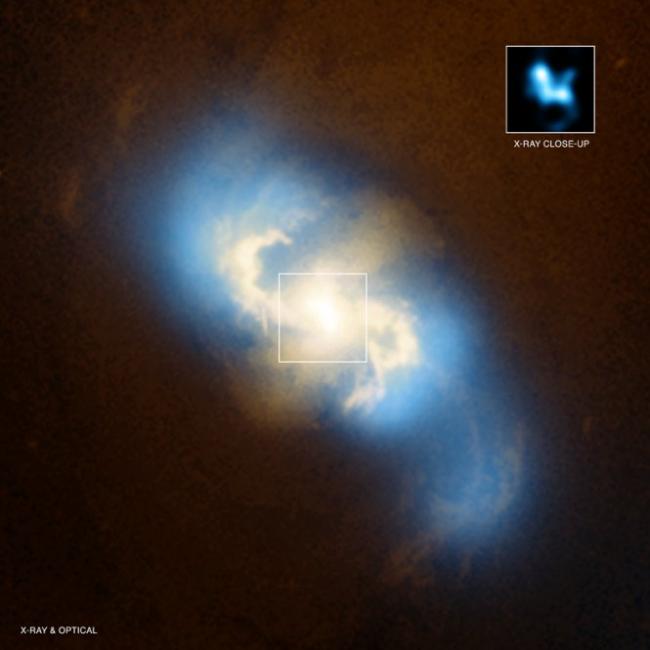
An X-ray (blue) and optical (yellow) image of the galaxy NGC3933. New results on the black holes in this galaxy imply that the galaxy is the result of a collision between two unequally-sized galaxies. The inset box shows the central region of NGC 3993 as observed by Chandra.
The current picture of galaxy evolution argues that galaxies often collide and merge, and that when they do so the black holes at their centers also ultimately come together to orbit one another as a pair. The orbiting black holes radiate gravitational waves and eventually merge together. When the two original galaxies are of comparable masses, the interaction is called a major merger and can lead to the formation of an elliptical galaxy. There are known cases of binary black holes in galaxies that resulted from major mergers, and X-ray observations can confirm their masses and orbital properties. However, the most common type of merger should involve galaxies of unequal masses, a so-called minor merger, but so far there have been no known examples of black hole pairs resulting from a minor merger, and if the models are accurate this lack needs to be addressed. Moreover it is hard to determine if a galaxy is actually the product of a minor merger; a pair of black holes would be the smoking gun.
The galaxy NGC 3393 is about 160 million light years away. It is notable for hosting the nearest known pair of orbiting supermassive black holes, with the two separated by a mere 430 light years (for comparison, in our galaxy the distance from the sun to the nuclear black hole is about 27,000 light-years). It is thought that NGC 3393 is probably the result of a minor merger, but this is uncertain because a merged galaxy can look like an ordinary spiral galaxy. If this was a minor merger, however, the black hole from the smaller galaxy should have had a smaller mass than the other black hole before the host galaxies collided.
CfA astronomers Pepi Fabbiano, Junfeng Wang, Martin Elvis, and Guido Risaliti have measured the masses of the two black holes using the Chandra X-ray Observatory. They report in the journal Nature that in NGC3393 the black holes have slightly different masses, and, together with other details of the galaxy, conclude that it is indeed the result of a minor merger. The results help to confirm the overall picture of galaxy merging, and in addition suggest that the smaller black holes may have grown in size during the interaction by accreting material.